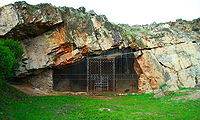La Siberia
39°09′00″N 05°06′00″W / 39.15000°N 5.10000°W
La Siberia | ||
|---|---|---|
Capital Herrera del Duque | | |
| Municipalities | ||
| Area | ||
| • Total | 2,836.7 km2 (1,095.3 sq mi) | |
| Population (2015) | ||
| • Total | 21,422 | |
| • Density | 7.6/km2 (20/sq mi) | |
UTC+2 (CEST) | ||
| Largest municipality | Herrera del Duque | |
La Siberia is a
Municipalities
La Siberia contains 18 municipalities:
- Herrera del Duque (capital)
- Baterno
- Casas de Don Pedro
- Castilblanco
- Esparragosa de Lares
- Fuenlabrada de los Montes
- Garbayuela
- Garlitos
- Helechosa de los Montes
- Navalvillar de Pela
- Puebla de Alcocer
- El Risco
- Sancti-Spiritus
- Siruela
- Talarrubias
- Tamurejo
- Valdecaballeros
- Villarta de los Montes
History

La Siberia dates back to
Geography
La Siberia is a land of varying terrain. The foothills of the
Flora and fauna
With a population density of just under 10 inhabitants per square kilometre (26/sq mi), much lower than Spain's average of 70/km2 (180/sq mi), the area's landscape is dominated by a very diverse collection of trees, the most dominant being the oak.[8] Other types of trees include quercus faginea, chestnut, ash, willow, eucalyptus, and pine.
Almost all of the region has been declared a
Hunting small game is a common pastime in La Siberia; the most-prized animal being the
Fishing is also popular in the comarca. Fish native to the area include
Climate
La Siberia lies between two climate zones - a continental climate to the north and a Mediterranean climate to the south - making this area a transition zone. Most of the area lies in the Mediterranean zone, but the far north has a continental climate. Summers are long and hot while winters are short and moderately cold.[2]
La Siberia has an average high of 23.3 °C (73.9 °F) and an average low of 9.9 °C (49.8 °F). The hottest month is July with an average high/low of 34.3 °C (93.7 °F)/17.0 °C (62.6 °F), and the coldest month is January with an average high/low of 13.9 °C (57.0 °F)/3.2 °C (37.8 °F).[11]
The region only receives 463 mm (18.2 in) per year, lower than Spain's average, 639.5 mm (25.18 in).[12] The wettest month of the year is December, receiving 73 mm (2.9 in) of precipitation, and the driest month is July, receiving only 4 mm (0.16 in).[11]
References
- ^ Geography of La Siberia (Spanish)[permanent dead link]
- ^ a b c d e La Siberia (Spanish) Archived 2008-12-11 at the Wayback Machine
- ^ Microbiological analysis of Maltravieso Cave[dead link]
- ^ Maltravieso Cave (Spanish)
- ^ Reservoirs of La Serena and La Siberia (Spanish) Archived 2008-09-15 at the Wayback Machine
- ^ Nature in La Siberia (Spanish) Archived 2007-06-17 at archive.today
- ^ Water Trails in Extremadura (Spanish)
- ^ a b Areas of Action (Spanish)[permanent dead link]
- ^ Hunting and fishing in La Siberia (Spanish)
- ^ Species of fish in La Siberia (Spanish)
- ^ a b Climate of Badajoz Archived 2011-07-20 at the Wayback Machine. Figures are actually from Badajoz, but they should be pretty close.
- ^ Climate of Spain
External links
- Official website of La Siberia
- Information about La Siberia and Extremadura
- Diputación de Badajoz, Comarcas
